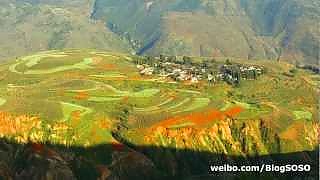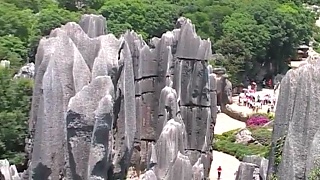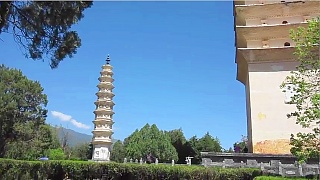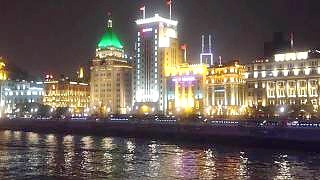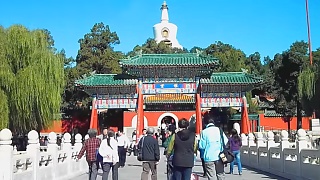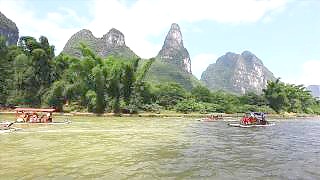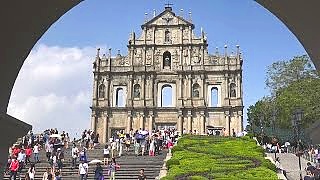KunMing: 20 Kid-Friendly Places to Visit
- Kunming Zoo (昆明动物园 Kūnmíng Dòngwùyuán): Zoo with a variety of animals, shows, and educational programs.
- Dianchi Lake (滇池 Diānchí): Scenic lake with parks, boat rides, and recreational activities.
- Yunnan Nationalities Village (云南民族村 Yúnnán Mínzú Cūn): Cultural theme park with ethnic minority exhibits, performances, and crafts.
- Green Lake Park (翠湖 Cuìhú): Park with gardens, pavilions, and scenic views.
- Yunnan Museum of Minority Nationalities (云南民族博物馆 Yúnnán Mínzú Bówùguǎn): Museum with exhibits on Yunnan's ethnic minorities, cultures, and traditions.
- Yunnan Railway Museum (云南铁路博物馆 Yúnnán Tiělù Bówùguǎn): Museum with exhibits on Yunnan's railway history, technology, and artifacts.
- Yuantong Temple (圆通寺 Yuántōng Sì): Buddhist temple with historic buildings, gardens, and statues.
- Yunnan Wild Animal Park (云南野生动物园 Yúnnán Yěshēng Dòngwùyuán): Safari park with a variety of animals, shows, and interactive experiences.
- Haigeng Park (海埂公园 Hǎigěng Gōngyuán): Park with lakes, gardens, and scenic spots.
- Kunming Botanical Garden (昆明植物园 Kūnmíng Zhíwùyuán): Botanical garden with diverse plant collections, greenhouses, and walking trails.
- Kunming World Horticulture Expo Garden (昆明世博园 Kūnmíng Shìbóyuán): Garden with themed areas, pavilions, and horticultural displays.
- Western Hills Forest Reserve (西山森林公园 Xīshān Sēnlín Gōngyuán): Nature reserve with hiking trails, temples, and panoramic views of Kunming.
- Kunming Grand View Park (昆明大观楼 Kūnmíng Dàguān Lóu): Park with traditional Chinese architecture, gardens, and viewpoints.
- Yunnan Nationalities Museum (云南省民族博物馆 Yúnnán Shěng Mínzú Bówùguǎn): Museum with exhibits on Yunnan's ethnic minorities, history, and cultures.
- Kunming Stone Forest Geological Park (昆明石林风景区 Kūnmíng Shílín Fēngjǐngqū): UNESCO World Heritage Site with unique limestone formations, caves, and trails.
- Golden Temple Park (金殿公园 Jīndiàn Gōngyuán): Park with a Taoist temple, gardens, and scenic landscapes.
- Yunnan Military Academy Museum (云南陆军讲武堂博物馆 Yúnnán Lùjūn Jiǎngwǔtáng Bówùguǎn): Museum with exhibits on Yunnan's military history, uniforms, and weapons.
- Kunming Daguan Park (昆明大观公园 Kūnmíng Dàguān Gōngyuán): Park with lakes, pavilions, and traditional Chinese architecture.
- Yunnan Nationalities University (云南民族大学 Yúnnán Mínzú Dàxué): University campus with architectural features, gardens, and cultural events.
- Kunming Zoo (昆明动物园 Kūnmíng Dòngwùyuán): Zoo with a variety of animals, shows, and educational programs.
KunMing: 30 More Places to Visit
- Yunnan Provincial Museum (云南省博物馆 Yúnnán Shěng Bówùguǎn): Museum with exhibits on Yunnan's history, culture, and artifacts.
- Yuantong Mountain (圆通山 Yuántōng Shān): Scenic mountain with temples, pagodas, and hiking trails.
- Kunming Golden Temple (昆明金殿 Kūnmíng Jīndiàn): Taoist temple with a golden pavilion, gardens, and cultural exhibits.
- Yunnan Railway Museum (云南铁路博物馆 Yúnnán Tiělù Bówùguǎn): Museum with exhibits on Yunnan's railway history, technology, and artifacts.
- Kunming Western Hills Forest Reserve (昆明西山森林公园 Kūnmíng Xīshān Sēnlín Gōngyuán): Nature reserve with temples, hiking trails, and panoramic views of Kunming.
- Kunming Flowers and Birds Market (昆明花鸟市场 Kūnmíng Huāniǎo Shìchǎng): Market with flowers, birds, pets, and gardening supplies.
- Green Lake Park (翠湖 Cuìhú): Park with gardens, pavilions, and scenic views.
- Dianchi Lake (滇池 Diānchí): Scenic lake with parks, boat rides, and recreational activities.
- Kunming World Horticulture Expo Garden (昆明世博园 Kūnmíng Shìbóyuán): Garden with themed areas, pavilions, and horticultural displays.
- Stone Forest (石林 Shílín): UNESCO World Heritage Site with unique limestone formations, caves, and hiking trails.
- Yunnan University (云南大学 Yúnnán Dàxué): University campus with historic buildings, gardens, and cultural events.
- Kunming Dragon Gate (西山龙门 Xīshān Lóngmén): Taoist temple complex with sculptures, caves, and panoramic views.
- Green Lake Park (翠湖 Cuìhú): Park with gardens, pavilions, and scenic views.
- Kunming Cuihu Park (昆明翠湖公园 Kūnmíng Cuìhú Gōngyuán): Park with a lake, pavilions, and walking paths.
- Kunming Confucius Temple (昆明文庙 Kūnmíng Wénmiào): Confucian temple with historic architecture, gardens, and cultural events.
- Yuantong Temple (圆通寺 Yuántōng Sì): Buddhist temple with historic buildings, gardens, and statues.
- Kunming Grand View Park (昆明大观楼 Kūnmíng Dàguān Lóu): Park with traditional Chinese architecture, gardens, and viewpoints.
- Kunming Flowers and Birds Market (昆明花鸟市场 Kūnmíng Huāniǎo Shìchǎng): Market with flowers, birds, pets, and gardening supplies.
- Yunnan Museum (云南省博物馆 Yúnnán Shěng Bówùguǎn): Museum with exhibits on Yunnan's history, culture, and artifacts.
- Kunming Western Hills Forest Reserve (昆明西山森林公园 Kūnmíng Xīshān Sēnlín Gōngyuán): Nature reserve with temples, hiking trails, and panoramic views of Kunming.
- Kunming Dragon Gate (西山龙门 Xīshān Lóngmén): Taoist temple complex with sculptures, caves, and panoramic views.
- Green Lake Park (翠湖 Cuìhú): Park with gardens, pavilions, and scenic views.
- Dianchi Lake (滇池 Diānchí): Scenic lake with parks, boat rides, and recreational activities.
- Yunnan Nationalities Village (云南民族村 Yúnnán Mínzú Cūn): Cultural theme park with ethnic minority exhibits, performances, and crafts.
- Yunnan Provincial Museum (云南省博物馆 Yúnnán Shěng Bówùguǎn): Museum with exhibits on Yunnan's history, culture, and artifacts.
- Kunming Golden Temple (昆明金殿 Kūnmíng Jīndiàn): Taoist temple with a golden pavilion, gardens, and cultural exhibits.
- Yunnan Nationalities University (云南民族大学 Yúnnán Mínzú Dàxué): University campus with architectural features, gardens, and cultural events.
- Kunming Cuihu Park (昆明翠湖公园 Kūnmíng Cuìhú Gōngyuán): Park with a lake, pavilions, and walking paths.
- Kunming Confucius Temple (昆明文庙 Kūnmíng Wénmiào): Confucian temple with historic architecture, gardens, and cultural events.
- Stone Forest (石林 Shílín): UNESCO World Heritage Site with unique limestone formations, caves, and hiking trails.
Kunming, the capital of China's Yunnan province, is known as the 'City of Eternal Spring' due to its mild climate year-round. It's a vibrant city with a rich cultural heritage, stunning natural scenery, and diverse ethnic minority communities. Here's a guide for tourists visiting Kunming:
Natural Attractions:
Stone Forest (Shilin): Located about 90 kilometers southeast of Kunming, the Stone Forest is a UNESCO World Heritage Site known for its surreal limestone formations resembling a forest of stone pillars. Visitors can explore the maze-like paths, visit local villages, and learn about the Yi ethnic minority culture.
Dianchi Lake: Kunming's largest lake offers scenic views, waterfront parks, and recreational activities such as boating and fishing. Nearby attractions include the Yunnan Nationalities Village, where visitors can learn about the diverse cultures of Yunnan's ethnic minority groups.
Jiaozi Snow Mountain: This scenic area northwest of Kunming features snow-capped peaks, alpine meadows, and hiking trails. Visitors can take a cable car ride to enjoy panoramic views of the surrounding landscape.
Cultural and Historical Sites:
Yuantong Temple: Dating back over 1,200 years, Yuantong Temple is one of the oldest and most important Buddhist temples in Kunming. It features traditional architecture, serene gardens, and ornate halls with Buddhist statues and artifacts.
Kunming Old Street (Guandu Ancient Town): Explore the historic streets and traditional architecture of Guandu Ancient Town, located on the outskirts of Kunming. Highlights include the Guandu Old Bridge, temples, and local markets.
Ethnic Minority Culture:
Yunnan Ethnic Village: This cultural theme park showcases the diverse traditions, customs, and architecture of Yunnan's ethnic minority groups, including the Yi, Bai, Dai, and Hani people. Visitors can watch cultural performances, shop for handicrafts, and sample ethnic cuisine.
Golden Temple (Jin Dian): Located on Mingfeng Hill, the Golden Temple is a Taoist temple complex known for its large copper pavilion covered in gold leaf. It offers panoramic views of Kunming and the surrounding countryside.
Modern Attractions:
Green Lake Park (Cuihu Park): This urban park in central Kunming is a popular recreational spot for locals and tourists alike. It features scenic walking paths, pavilions, gardens, and a variety of bird species.
Daguan Park: Known for its expansive lake and picturesque views of the Western Hills, Daguan Park is a tranquil retreat from the city's hustle and bustle. Visitors can stroll along the lakeside promenade, enjoy traditional tea houses, and admire the park's classical Chinese architecture.
Practical Tips:
Transportation: Kunming has a well-developed public transportation system, including buses and the Kunming Metro. Taxis and ride-hailing services are also widely available.
Weather: Kunming enjoys a mild climate year-round, but it can be cool and rainy in the winter months. It's advisable to check the weather forecast and pack accordingly.
Language: Mandarin Chinese is the official language, but English may not be widely spoken outside of tourist areas. It's helpful to learn a few basic phrases or carry a translation app, especially when interacting with locals from ethnic minority groups.
Kunming's blend of natural beauty, cultural diversity, and historical charm makes it a fascinating destination for tourists. Whether you're exploring ancient temples, admiring stunning landscapes, or immersing yourself in ethnic minority culture, Kunming offers a unique and memorable experience for visitors of all interests.
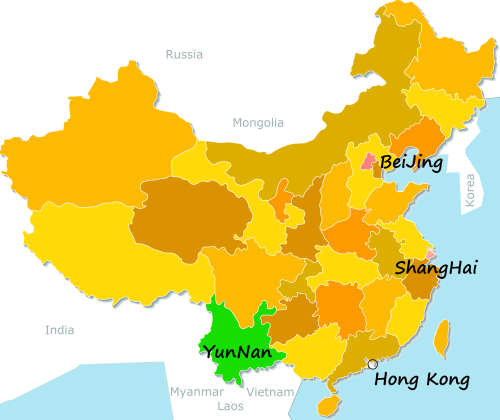
 50 places to visit in KunMing
50 places to visit in KunMing
